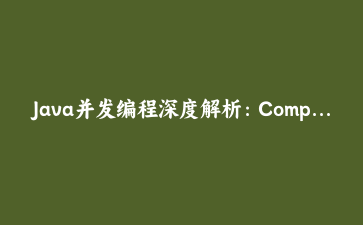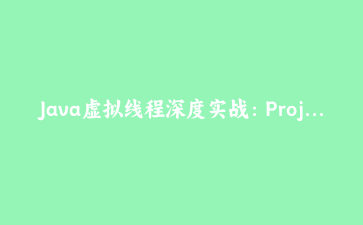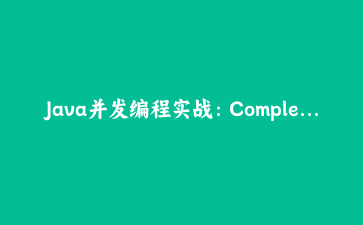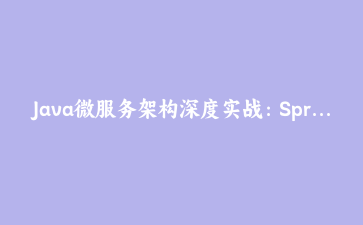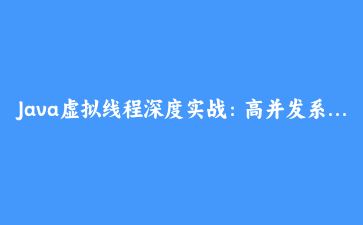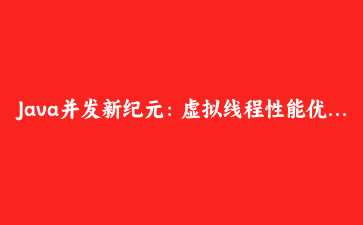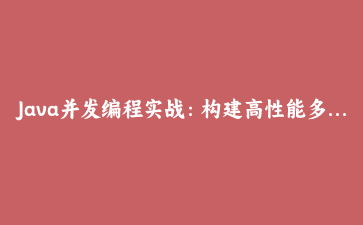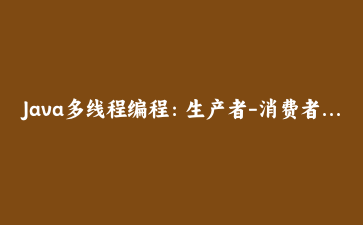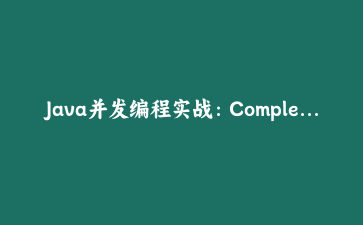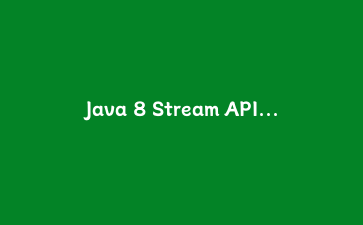掌握现代Java异步编程核心技术,构建高性能并发应用
1. CompletableFuture核心概念与设计理念
CompletableFuture是Java 8引入的强大异步编程工具,它不仅继承了Future的特性,还提供了丰富的组合式异步编程能力,彻底改变了Java处理并发任务的方式。
1.1 与传统Future的对比
import java.util.concurrent.*;
// 传统Future的使用局限
ExecutorService executor = Executors.newFixedThreadPool(2);
Future<String> future = executor.submit(() -> {
Thread.sleep(1000);
return "传统Future结果";
});
// 获取结果时会阻塞线程
try {
String result = future.get(); // 阻塞调用
System.out.println(result);
} catch (Exception e) {
e.printStackTrace();
}
// CompletableFuture的非阻塞特性
CompletableFuture<String> completableFuture = CompletableFuture.supplyAsync(() -> {
try {
Thread.sleep(1000);
} catch (InterruptedException e) {
throw new IllegalStateException(e);
}
return "CompletableFuture结果";
});
// 非阻塞处理结果
completableFuture.thenAccept(result -> System.out.println("异步处理: " + result));2. CompletableFuture核心API深度解析
理解CompletableFuture的四大核心操作类型:创建、转换、组合和消费。
2.1 异步任务创建与执行
import java.util.concurrent.CompletableFuture;
import java.util.concurrent.ExecutorService;
import java.util.concurrent.Executors;
public class CompletableFutureCreation {
private static final ExecutorService customExecutor =
Executors.newFixedThreadPool(4, r -> {
Thread t = new Thread(r);
t.setDaemon(true);
return t;
});
// 使用默认ForkJoinPool
public static CompletableFuture<String> createWithSupplyAsync() {
return CompletableFuture.supplyAsync(() -> {
System.out.println("执行线程: " + Thread.currentThread().getName());
return "supplyAsync结果";
});
}
// 使用自定义线程池
public static CompletableFuture<String> createWithCustomExecutor() {
return CompletableFuture.supplyAsync(() -> {
System.out.println("自定义线程池: " + Thread.currentThread().getName());
return "自定义执行器结果";
}, customExecutor);
}
// 基于已有结果创建
public static CompletableFuture<String> createCompletedFuture() {
return CompletableFuture.completedFuture("预计算结果");
}
public static void main(String[] args) {
createWithSupplyAsync().thenAccept(System.out::println);
createWithCustomExecutor().thenAccept(System.out::println);
createCompletedFuture().thenAccept(System.out::println);
}
}2.2 结果转换与处理链
public class TransformationExamples {
// thenApply - 同步转换
public static CompletableFuture<Integer> transformStringToLength() {
return CompletableFuture.supplyAsync(() -> "Hello World")
.thenApply(String::length)
.thenApply(length -> length * 2);
}
// thenApplyAsync - 异步转换
public static CompletableFuture<String> transformAsync() {
return CompletableFuture.supplyAsync(() -> "原始数据")
.thenApplyAsync(data -> {
System.out.println("异步转换线程: " + Thread.currentThread().getName());
return data + " - 异步处理";
});
}
// thenCompose - 扁平化转换(避免嵌套CompletableFuture)
public static CompletableFuture<String> flatMapTransformation() {
return CompletableFuture.supplyAsync(() -> "用户ID:123")
.thenCompose(userId -> getUserDetails(userId));
}
private static CompletableFuture<String> getUserDetails(String userId) {
return CompletableFuture.supplyAsync(() ->
userId + " - 详细信息: {name: '张三', age: 25}"
);
}
// 处理完成后的消费操作
public static void consumptionExample() {
CompletableFuture.supplyAsync(() -> "生产的数据")
.thenAccept(data -> System.out.println("消费数据: " + data))
.thenRun(() -> System.out.println("清理操作完成"));
}
}3. 复杂任务组合与编排实战
CompletableFuture真正的威力在于其强大的任务组合能力。
3.1 并行任务组合
public class TaskCombination {
// thenCombine - 两个独立任务的结果组合
public static CompletableFuture<String> combineUserAndOrder() {
CompletableFuture<String> userFuture = getUserInfo();
CompletableFuture<String> orderFuture = getOrderInfo();
return userFuture.thenCombine(orderFuture, (user, order) ->
"用户信息: " + user + ", 订单信息: " + order
);
}
// allOf - 等待所有任务完成
public static CompletableFuture<Void> executeAllTasks() {
CompletableFuture<String> task1 = CompletableFuture.supplyAsync(() -> "任务1");
CompletableFuture<String> task2 = CompletableFuture.supplyAsync(() -> "任务2");
CompletableFuture<String> task3 = CompletableFuture.supplyAsync(() -> "任务3");
return CompletableFuture.allOf(task1, task2, task3)
.thenRun(() -> System.out.println("所有任务执行完成"));
}
// anyOf - 获取最先完成的任务
public static CompletableFuture<Object> getFastestResult() {
CompletableFuture<String> fastTask = CompletableFuture.supplyAsync(() -> {
try { Thread.sleep(100); } catch (InterruptedException e) {}
return "快速任务";
});
CompletableFuture<String> slowTask = CompletableFuture.supplyAsync(() -> {
try { Thread.sleep(1000); } catch (InterruptedException e) {}
return "慢速任务";
});
return CompletableFuture.anyOf(fastTask, slowTask);
}
private static CompletableFuture<String> getUserInfo() {
return CompletableFuture.supplyAsync(() -> "用户张三");
}
private static CompletableFuture<String> getOrderInfo() {
return CompletableFuture.supplyAsync(() -> "订单号:ORD001");
}
}3.2 复杂业务流程编排
public class BusinessWorkflow {
public static class OrderService {
public CompletableFuture<String> validateOrder(String orderId) {
return CompletableFuture.supplyAsync(() -> {
System.out.println("验证订单: " + orderId);
if (orderId.startsWith("INV")) {
return orderId;
}
throw new IllegalArgumentException("无效订单ID");
});
}
public CompletableFuture<Double> calculateAmount(String orderId) {
return CompletableFuture.supplyAsync(() -> {
System.out.println("计算金额: " + orderId);
return 250.0;
});
}
}
public static class PaymentService {
public CompletableFuture<String> processPayment(Double amount) {
return CompletableFuture.supplyAsync(() -> {
System.out.println("处理支付: " + amount);
if (amount > 200) {
return "支付成功,交易号: TXN" + System.currentTimeMillis();
}
throw new RuntimeException("金额不足");
});
}
}
public static class NotificationService {
public CompletableFuture<String> sendConfirmation(String transactionId) {
return CompletableFuture.supplyAsync(() -> {
System.out.println("发送确认通知: " + transactionId);
return "通知发送成功";
});
}
}
// 编排完整的订单处理流程
public static CompletableFuture<String> processOrder(String orderId) {
OrderService orderService = new OrderService();
PaymentService paymentService = new PaymentService();
NotificationService notificationService = new NotificationService();
return orderService.validateOrder(orderId)
.thenCompose(orderService::calculateAmount)
.thenCompose(paymentService::processPayment)
.thenCompose(notificationService::sendConfirmation)
.exceptionally(throwable -> {
System.err.println("订单处理失败: " + throwable.getMessage());
return "订单处理失败: " + throwable.getMessage();
});
}
public static void main(String[] args) {
processOrder("INV001")
.thenAccept(result -> System.out.println("最终结果: " + result))
.join(); // 等待异步操作完成(仅用于演示)
}
}4. 高级特性与错误处理机制
掌握CompletableFuture的高级特性和健壮的错误处理策略。
4.1 完整的错误处理链
public class ErrorHandlingAdvanced {
// exceptionally - 捕获异常并提供默认值
public static CompletableFuture<String> handleWithDefault() {
return CompletableFuture.supplyAsync(() -> {
if (Math.random() > 0.5) {
throw new RuntimeException("随机失败");
}
return "成功结果";
}).exceptionally(throwable -> "默认值 - " + throwable.getMessage());
}
// handle - 统一处理成功和异常情况
public static CompletableFuture<String> handleBothCases() {
return CompletableFuture.supplyAsync(() -> {
if (Math.random() > 0.3) {
return "业务数据";
}
throw new IllegalStateException("业务异常");
}).handle((result, throwable) -> {
if (throwable != null) {
return "错误恢复: " + throwable.getMessage();
}
return "处理成功: " + result;
});
}
// 组合操作中的错误传播
public static CompletableFuture<String> errorPropagation() {
return CompletableFuture.supplyAsync(() -> "第一步")
.thenApplyAsync(firstStep -> {
if (firstStep.contains("第一步")) {
throw new RuntimeException("第二步失败");
}
return firstStep + " -> 第二步";
})
.thenApplyAsync(secondStep -> secondStep + " -> 第三步")
.exceptionally(throwable -> "整个链式失败: " + throwable.getMessage());
}
// 超时控制
public static CompletableFuture<String> withTimeout() {
CompletableFuture<String> task = CompletableFuture.supplyAsync(() -> {
try {
Thread.sleep(2000); // 模拟长时间运行
return "任务完成";
} catch (InterruptedException e) {
throw new RuntimeException(e);
}
});
CompletableFuture<String> timeout = CompletableFuture.supplyAsync(() -> {
try {
Thread.sleep(1000);
return "超时";
} catch (InterruptedException e) {
throw new RuntimeException(e);
}
});
return task.applyToEither(timeout, result -> result)
.exceptionally(throwable -> "操作失败: " + throwable.getMessage());
}
}5. 性能优化与最佳实践
在生产环境中使用CompletableFuture的性能调优技巧和最佳实践。
5.1 线程池配置策略
import java.util.concurrent.*;
public class PerformanceOptimization {
// CPU密集型任务线程池
private static final ExecutorService cpuBoundExecutor =
Executors.newFixedThreadPool(
Runtime.getRuntime().availableProcessors(),
new ThreadFactory() {
private final AtomicInteger counter = new AtomicInteger(1);
@Override
public Thread newThread(Runnable r) {
Thread t = new Thread(r, "cpu-pool-" + counter.getAndIncrement());
t.setPriority(Thread.NORM_PRIORITY);
return t;
}
});
// IO密集型任务线程池
private static final ExecutorService ioBoundExecutor =
Executors.newFixedThreadPool(50, r -> {
Thread t = new Thread(r);
t.setDaemon(true);
return t;
});
public static CompletableFuture<String> executeCpuIntensiveTask() {
return CompletableFuture.supplyAsync(() -> {
// 模拟CPU密集型计算
long result = 0;
for (int i = 0; i {
// 模拟IO操作
try {
Thread.sleep(100);
} catch (InterruptedException e) {
throw new RuntimeException(e);
}
return "IO任务完成";
}, ioBoundExecutor);
}
// 资源清理
public static void shutdown() {
cpuBoundExecutor.shutdown();
ioBoundExecutor.shutdown();
}
}5.2 监控与调试技巧
public class MonitoringUtils {
// 添加执行时间监控
public static <T> CompletableFuture<T> withTiming(
CompletableFuture<T> future, String operationName) {
long startTime = System.currentTimeMillis();
return future.whenComplete((result, throwable) -> {
long duration = System.currentTimeMillis() - startTime;
System.out.printf("操作 '%s' 执行时间: %dms%n", operationName, duration);
});
}
// 线程跟踪
public static <T> CompletableFuture<T> withThreadTracking(
Supplier<T> supplier, String taskName) {
return CompletableFuture.supplyAsync(() -> {
System.out.printf("任务 '%s' 在线程 %s 执行%n",
taskName, Thread.currentThread().getName());
return supplier.get();
});
}
}6. 实战案例:电商订单异步处理系统
构建一个完整的电商订单异步处理系统,展示CompletableFuture在真实场景中的应用。
import java.util.concurrent.*;
import java.util.*;
public class ECommerceOrderSystem {
static class Order {
String orderId;
String userId;
List<String> productIds;
double totalAmount;
String status;
Order(String orderId, String userId, List<String> productIds, double amount) {
this.orderId = orderId;
this.userId = userId;
this.productIds = productIds;
this.totalAmount = amount;
this.status = "PENDING";
}
}
static class InventoryService {
public CompletableFuture<Boolean> checkStock(List<String> productIds) {
return CompletableFuture.supplyAsync(() -> {
System.out.println("检查库存: " + productIds);
try { Thread.sleep(200); } catch (InterruptedException e) {}
return productIds.stream().allMatch(id -> id.startsWith("PROD"));
});
}
}
static class PricingService {
public CompletableFuture<Double> calculateDiscount(String userId, double amount) {
return CompletableFuture.supplyAsync(() -> {
System.out.println("计算折扣: 用户=" + userId + ", 金额=" + amount);
try { Thread.sleep(150); } catch (InterruptedException e) {}
return amount > 100 ? amount * 0.9 : amount;
});
}
}
static class PaymentGateway {
public CompletableFuture<String> processPayment(String orderId, double amount) {
return CompletableFuture.supplyAsync(() -> {
System.out.println("处理支付: 订单=" + orderId + ", 金额=" + amount);
try { Thread.sleep(300); } catch (InterruptedException e) {}
if (amount > 0) {
return "PAYMENT_SUCCESS_" + System.currentTimeMillis();
}
throw new RuntimeException("支付金额无效");
});
}
}
static class ShippingService {
public CompletableFuture<String> scheduleDelivery(String orderId, String address) {
return CompletableFuture.supplyAsync(() -> {
System.out.println("安排配送: 订单=" + orderId);
try { Thread.sleep(250); } catch (InterruptedException e) {}
return "SHIPPING_SCHEDULED_" + orderId;
});
}
}
public static CompletableFuture<String> processCompleteOrder(Order order) {
InventoryService inventory = new InventoryService();
PricingService pricing = new PricingService();
PaymentGateway payment = new PaymentGateway();
ShippingService shipping = new ShippingService();
return inventory.checkStock(order.productIds)
.thenCompose(hasStock -> {
if (!hasStock) {
throw new RuntimeException("库存不足");
}
return pricing.calculateDiscount(order.userId, order.totalAmount);
})
.thenCompose(discountedAmount ->
payment.processPayment(order.orderId, discountedAmount)
)
.thenCompose(paymentId ->
shipping.scheduleDelivery(order.orderId, "用户地址")
)
.thenApply(shippingId -> {
order.status = "COMPLETED";
return "订单处理完成: " + order.orderId +
", 配送ID: " + shippingId;
})
.exceptionally(throwable -> {
order.status = "FAILED";
return "订单处理失败: " + order.orderId +
", 原因: " + throwable.getMessage();
});
}
public static void main(String[] args) {
Order order = new Order(
"ORDER_001",
"USER_123",
Arrays.asList("PROD_A", "PROD_B"),
150.0
);
processCompleteOrder(order)
.thenAccept(System.out::println)
.join();
System.out.println("订单最终状态: " + order.status);
}
}7. 总结与进阶学习路径
通过本文的深入学习,我们掌握了CompletableFuture的核心概念、高级特性和实战应用。CompletableFuture为Java异步编程提供了强大的工具,使得复杂的并发任务编排变得简单直观。
关键要点总结:
- 理解CompletableFuture的链式编程模型
- 掌握任务组合与编排的核心API
- 实现健壮的错误处理机制
- 优化线程池配置提升性能
- 在实际业务场景中应用异步编程模式
进阶学习建议:深入研究Project Loom的虚拟线程、响应式编程框架,以及微服务架构中的异步通信模式。


